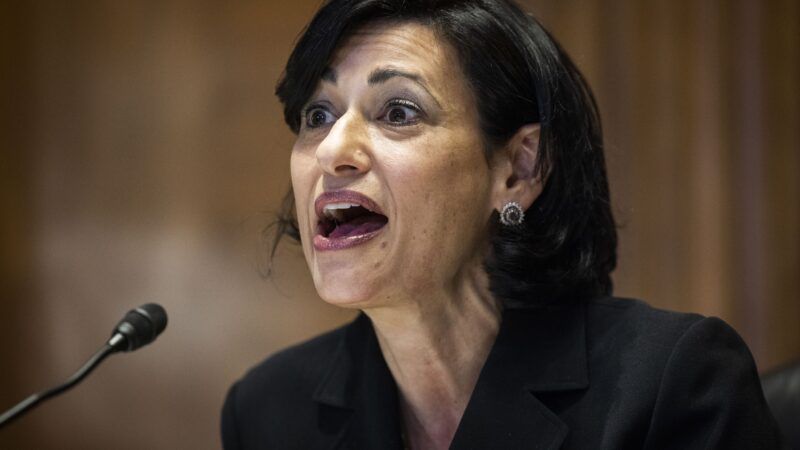An Epidemiologist Confirms That the CDC Director Misrepresented Her Study of Outdoor COVID-19 Transmission
A co-author of the article that Rochelle Walensky cited says outdoor settings probably account for "substantially less than 1 percent" of infections.

After Rochelle Walensky, director of the Centers for Disease Control and Prevention (CDC), was criticized for grossly exaggerating the risk of outdoor COVID-19 transmission, she said she was relying on a study published in "one of our top infectious disease journals." But as I noted a couple of weeks ago, Walensky misrepresented that study, which was published by The Journal of Infectious Diseases in February, in several significant ways. Today New York Times columnist David Leonhardt, who first called attention to Walensky's hyperbole, reports that a co-author of the study agrees the CDC director's gloss was misleading.
Walensky estimated that outdoor transmission accounted for "less than 10 percent" of COVID-19 cases, implying that its share is close to that number. The abstract of the article she cited said "five identified studies found a low proportion of reported global SARS-CoV-2 infections occurred outdoors (<10%)." But the evidence described in the article is inconsistent with the idea that anything like 10 percent of infections happen outside. Nooshin Razani, a pediatrician and epidemiologist who co-authored the study, told Leonhardt the actual number is "probably substantially less than 1 percent."
Walensky's implication that close to 10 percent of infections can be traced to outdoor transmission—a figure that may be off by two orders of magnitude—never made sense. "Given that 90% of time is spent indoors in high- and middle-income countries," Razani and her co-authors noted, "it would be expected that 90% of transmission occurs indoors, all else being equal." If outdoor transmission's share were in the neighborhood of 10 percent, in other words, the outdoor risk would be nearly as high as the indoor risk. Yet Walensky herself said there is "almost a 20-fold increased risk of transmission in the indoor setting [compared to] the outdoor setting."
Instead of admitting she made a mistake, Walensky doubled down. During a May 11 Senate hearing, she said her estimate was based on the Journal of Infectious Diseases article. The "top line result" of that study, she told Sen. Susan Collins (R–Maine), was that "less than 10 percent of cases were transmitted outdoors." But Walensky's description of the article suggested that neither she nor anyone on her staff had bothered to read the whole thing.
Walensky repeatedly described the article as a "meta-analysis." It was actually a systematic review, which searches and summarizes the relevant scientific literature, rather than a meta-analysis, which pools data from several studies to generate an overall result. The distinction matters because "meta-analysis" implies that the "less than 10 percent" estimate was calculated based on the underlying data from multiple studies. "We were very clear we were not making a summary number," Razani told Leonhardt.
Walensky also claimed "over 19 studies were included" in the systematic review. As the abstract noted, the review actually covered just five studies that looked specifically at COVID-19, only three of which generated data that could be used to estimate outdoor transmission's share of infections. One study found that outdoor settings accounted for 0.03 percent of infections; another put the share at less than 0.9 percent; and the third one found that "5% of work-related cases occurred outdoors."
That last estimate is probably biased upward because of misclassification. As Leonhardt has noted, infections among construction workers account for an outsized share of cases ascribed to outdoor settings. The likely explanation: Those infections were automatically treated as outdoor transmissions even though they may actually have happened indoors.
In any case, the data presented in Razani et al.'s article do not support the idea that the share of COVID-19 infections attributable to outdoor settings is anywhere near 10 percent. A more recent study that was not included in the systematic review found outdoor transmission accounted for 0.1 percent of infections in Ireland.
"The first sentence of our abstract states that a low proportion of reported global transmissions occur outdoors," Razani said on Twitter earlier this month. "Our review did not allow for us to quantify the amount of SARS-CoV-2 transmission occurring outdoors, nor did we state that 10% of transmissions occur outdoors." While "more research is needed to understand the risk outdoors versus indoors," she added, "our review suggests it is low (much lower than 10%)." Razani said that on May 11, after Walensky cited her study to back up the "less than 10 percent" estimate.
Razani also said "our main point" was that "people should spend time outdoors to enjoy nature and be active." She noted that "being outdoors is essentially the best ventilation one could ever imagine, as particles have the space to infinitely dilute, disperse, and eventually essentially disappear."
Walensky's persistent misrepresentation of the evidence concerning outdoor transmission is yet another example of how scientifically dubious statements and advice have undermined the CDC's credibility. More specifically, it informs absurdly cautious guidelines such as the CDC's recommendations for summer camps, which epidemiologists and infectious disease experts have criticized as "cruel," "irrational," and "unfairly draconian." Among other things, the CDC says campers and counselors should be required to wear face masks even during vigorous outdoor activities.
"There does not appear to be much scientific reason that campers and counselors, or most other people, should wear a mask outdoors all summer," Leonhardt notes. "Telling them to do so is an example of extreme caution—like staying out of the ocean to avoid sharks—that seems to have a greater cost than benefit."
In this case and others, Leonhardt observes, CDC officials "have acted as if extreme caution has no downsides." But "everything has downsides," he writes, "and it is the job of scientific experts and public-health officials to help the rest of us think clearly about the benefits and costs of our choices."

Show Comments (140)